Abstract
This research addresses how different leadership styles impact the organizational performance of Emirates Airlines. The scope of this study was narrowed down to four leadership styles: autocratic, democratic, transformational, and cross-cultural. A questionnaire including 17 elements, 5 of which concerned demographic and work-related characteristics, was distributed online to 200 employees, but only 130 responses contained relevant and measurable data.
Descriptive analysis and explanatory research design were used to assess the data and test five hypotheses. The results indicated that the autocratic style is not effective, while the democratic style has the most significant positive impact on organizational performance.
Furthermore, transformational and cross-cultural leadership styles also positively influence organizational performance. However, leaders who adhere to cross-cultural leadership need to create effective communication strategies to meet the needs of people coming from different ethnic backgrounds. Leaders also need to consider that there is no ideal leadership style so they need to assess the contemporary organizational environment and contingent factors to select or combine leadership strategies and lead a company to success.
Introduction
Background of the Study
A favorable economic climate in the UAE has led to the emergence of multiple enterprises in different industries. One of them is Emirates Airlines, based in Dubai, one of the biggest and most successful airlines in the Middle East. It substantially improved its punctuality in 2018 and was rated the second-most punctual airline in the region (Abbas, 2019). However, in May 2017, the carrier reported that its profits had plummeted 82 percent in the previous year, which was the first full-year profit decline during the last five years (Powley & Kerr, 2017).
These developments resulted mainly from changes in legislative regulations and laptop bans in the US so that Emirates was forced to cut flights to five out of twelve destinations in America. The company’s leaders were challenged to overcome a crisis and select an appropriate business model to ensure future profitability. Alkahtani (2016) emphasized that leaders should identify the best leadership style for managing their corporations. Therefore, this study will analyze how different leadership styles impact organizational performance based on the example of Emirates Airlines.
Statement of the Problem
Leadership is one of the most important factors that predict the effectiveness and success of a company’s operations. Moreover, effective leadership enables companies to outperform others and stay competitive in the market. Some experts in the field are convinced that “leadership facilitates organizational performance enhancement” (Bhargavi & Yassen, 2016, p. 2016). The aspect of communication is also vitally important because it describes the manner of interaction between the representatives of different hierarchical levels within a company.
It should be noted that the aviation industry in which Emirates Airline operates requires specific approaches to management and leadership to accommodate the needs of a culturally diverse workforce (De Brito Neto, 2014). Thus, this study aims to investigate the impact of the leadership styles of a company’s leaders on the performance of employees and the organization in general.
Aims and Objectives of the Study
The core aim of this study is to define the correlation between leadership styles and organizational performance from the perspective of communication. A particular objective concerns the impact of different leadership styles used by representatives of the Emirates management on employee and organizational performance. Another objective is to determine which specific leadership style, along with its corresponding communication strategies, positively influences organizational performance.
Scope of the Project
There is a variety of leadership styles that are often used at present in different organizations, while new types continue to evolve. However, Arab managers usually rely on a democratic style, which is also known as a participative leadership style (De Waal & Frijns, 2016). Taking into consideration that large organizations in the UAE operate in a multicultural context because they employ people of different nationalities, cross-cultural, and transformational leadership is also widely employed. These styles help to reduce miscommunication, tension, and conflicts between the employees of different socio-cultural or ethnic backgrounds. Therefore, this study will highlight and examine the autocratic, democratic, transformational, and cross-cultural leadership styles.
Focus of the Study
Even though the objectives of this study are to determine the impact of each leadership style mentioned on organizational performance and determine which one is most effective, the particular focus will be on how communication strategies influence performance. The consideration of this aspect is important because human resources constitute one of the most valuable assets of any company, regardless of the industry it operates in.
Significance of the Study
It is expected that the results of this study would benefit companies both in the worldwide aviation industry and other organizations that operate in a cross-cultural environment. The analysis of different leadership styles from the perspective of communication would also illustrate how the interaction between management and employees can either enhance or impair the performance of the latter. Also, further recommendations based on the results of this research are expected to be helpful for many corporations that practice one of the specified leadership styles.
Hypothesis
To meet the objectives of the study, five hypotheses will be outlined.
- Hypothesis 1. A leadership style and its corresponding communication strategies have a significant impact on organizational and employee performance.
- Hypothesis 2. An autocratic leadership style negatively influences organizational performance.
- Hypothesis 3. A democratic or participative leadership style positively influences organizational performance.
- Hypothesis 4. A transformational leadership style positively influences organizational performance.
- Hypothesis 5. Cross-cultural leadership does not significantly influence organizational performance.
Research Questions
The research questions are derived from the aims and objectives of the current research study.
- Question 1. What is the correlation between leadership style and organizational performance?
- Question 2. What specific leadership style has the most significant impact on organizational and employee performance from the perspective of communication?
Research Limitations
The first research limitation concerns the fact that this study is focused only on an examination of Emirates Airlines. Therefore, other organizations in the airline industry and other UAE-based firms should also be investigated. Furthermore, the second research limitation arises from the fact that only four leadership styles and their corresponding communication strategies are investigated. A wider range of leadership styles should be included in future research studies. The third research limitation is due to the limited number of the company’s employees that were able to participate in the survey for this study.
Literature Review
The role of a leader is crucial in any company. Currently, most managers of UAE enterprises are men, but gradually increasing involvement of women in regional leadership can already be observed (Abbas, 2018). There are many debates concerning which characteristics of a leader have a substantial impact on the effectiveness of the leadership style employed. Some experts argue that leadership is not conferred by chance at birth nor guaranteed by study at the best schools, but that intelligence, wisdom, and a strong personality are the most valuable innate qualities (Trapp, 2015).
De Brito Neto (2014) maintains that the ability of an individual to motivate and enable others to contribute towards the overall success of an organization is the core quality of a leader. Beyond personal qualities, managers also need to select the appropriate communication strategies that will ensure high-quality interaction with employees.
Leadership Styles and Communication
As leaders are supposed to persuade their followers, they need to explain their ideas and vision clearly to their audience. Communication constitutes one of the foundational materials from which leadership is constructed (Mayfield & Mayfield, 2017). Nevertheless, leadership theories suggest that communication should align with the corresponding leadership style (Khan, Nawaz, & Khan, 2015). Otherwise, the inconsistency may result in impaired efficiency and the reduced influence of the leader.
Leadership Styles and Organizational Performance
Autocratic
The autocratic style is characterized by the dominance of authoritarian leaders in organizations. They dictate to their subordinates what they should or should not do and are not interested in any kind of feedback (Bhargavi & Yassen, 2016). There is a clear distinction between the leader and the followers in the autocratic leadership framework. The leader aims to control employees by providing instruction-centric guidelines (Bhargavi & Yassen, 2016). This leadership style is associated with production-centered methods that aim to increase the effectiveness and competitiveness of a company (Alkahtani, 2016). Organizational performance might correspond to predefined indicators under the influence of authoritarian leadership, but job satisfaction among employees is usually low.
Democratic
Unlike the autocratic style, democratic leadership shifts from centralized decision making to the involvement of subordinates in the process. Democratic leadership is often referred to as participative because managers usually consider all the contributions and suggestions of employees, but have the authority to make final decisions when required (Bhargavi & Yassen, 2016). Therefore, this style is often characterized as a relationship-centered approach (Alkahtani, 2016).
Previous research studies have revealed that democratic leadership is very effective because it positively influences organizational performance and results in higher worker productivity (Bhargavi & Yassen, 2016). Overall, this style is employed by most leaders in different industries to optimize the operations of their companies.
Transformational
Transformational leadership is closely associated with changes within an organization. This style includes approaches to altering beliefs, values, and attitudes, highlighting the scope of change (Khan, Nawaz, & Khan, 2015; Alkahtani, 2016). Transformational leaders motivate others to question their expectations, rethink their ideas, and accomplish more than they are expected to (De Brito Neto, 2014; Alkahtani, 2016).
This style is based on five core constituents, including “idealized attributes and behavior, intellectual stimulation, inspirational motivation, and individual consideration” (Al Hammadi, 2018, p. 3184). It is predicted that individuals with more years of experience performing professional tasks will be more likely to implement a transformational leadership style in their practice to gain the maximum output from a project and enhance organizational performance (Yousif, Hossan, & McNeil, 2015). Effective communication strategies are vitally important for transformational leaders because they need to motivate their followers and convince them of the necessity of change.
Cross-cultural
The cross-cultural leadership style is relatively new because it emerged as a response to the rise of business in a globalized context. This style requires leaders to be highly flexible to adjust their strategies to contemporary changes and transformations. For instance, such companies as Emirates Airlines employ individuals from more than forty countries around the world (De Brito Neto, 2014). Thus most international firms implement cross-cultural leadership to boost the company’s performance and develop appropriate communication strategies.
Leadership in Emirates Airline
Even though Emirates Airline is a huge company based in Dubai, it has many regional offices, which means that there are different levels of management. Nevertheless, senior leaders have a substantial influence on the organizational climate and principles. Sheikh Ahmed bin Saeed Al Maktoum is chairman and chief executive. Under his leadership, Emirates Airlines has grown from a regional airline to an international one with a fleet of more than 260 aircraft (Leadership Team, n.d.). His leadership style can be identified as participatory, but being CEO of an international company provides him with flexibility in his senior management role.
Sir Tim Clark joined the airline during its early days as Head of Airline Planning. His prevailing leadership style is transformational, as he made significant contributions to the emergence of Emirates Airline as a global giant (Leadership Team, n.d.). Tim Clark holds that the sound business model he relied on starting in 2003 when he became a president of the company, is currently being challenged primarily for socio-economic and geopolitical reasons (Powley & Kerr, 2017).
New regulations and bans in the US have negatively influenced the revenues of Emirates Airlines because the company had to cut its flights to almost half of its destinations in America. Even though Tim Clark refuses to collaborate in the planning of corporate succession, he is the ideal person for adapting to new realities in the market (Powley & Kerr, 2017). For instance, he maintains that US airports welcome Emirates, and the results of recent meetings with officials prove this (Campbell, 2017). Tim Clark is ready to accept a challenge and respond to it, thus encouraging others to get involved in change management.
Another influential representative of the senior leadership team is Abdulaziz Al Ali, who is responsible for the human resources strategy. He manages the training, hiring, and retention of personnel and also policy development (Leadership Team, n.d.). However, there has been a range of complaints, initiated mostly by cabin crew staff, about some policies and regulations. For instance, workers who have been employed for less than three years are dismissed if they become pregnant, while maternity leave available to others also remains largely unpaid (Campbell, 2017).
The human resources chief admits that foreigners who come to the UAE know less about the country, while strict policies ensure the equality of employees from different backgrounds (Campbell, 2017). Consequently, the leadership style of Abdulaziz Al Ali can be defined as autocratic and cross-cultural.
Christopher Mueller joined Emirates only in the last several years, unlike most of the other senior leaders, who have worked at the company from the moment it was founded. He is the chief digital and innovation officer and his primary objective is to lead enterprise change management, guided by his previous experience (Leadership Team, n.d.). Mueller’s other tasks entail cutting costs and searching for new revenue opportunities (Powley & Kerr, 2017). Under his transformational leadership, Emirates has established new standards of technology, which makes the company highly competitive in the market.
Research Methodology
Research Design
This study incorporates an explanatory research design, which makes it possible to investigate the effect of a leadership style on organizational performance from the perspective of communication. In this case, leadership styles are independent variables, while organizational performance is a dependent one. Explanatory research design has several steps, the first of which is hypothesis formulation. Based on this step, more information is collected to achieve the objectives of the study and either confirm or refute a hypothesis.
Data Collection
This research study uses a quantitative approach to data collection. Structured questionnaires were designed with twelve questions related to organizational performance and democratic, autocratic, transformational, and cross-cultural leadership styles. Each question was based on a five-point Likert scale (1 – strongly disagree, 2 – disagree, 3 – neither agree nor disagree, 4 – agree, 5 – strongly agree), which facilitated the overall data collection process for respondents.
Also, questions about the years of work and current position in the company along with questions about demographic characteristics (age, gender, and nationality) were included. While 200 questionnaires were distributed to respondents online, only 130 were valid for data analysis. The discrepancy arises from the fact that 45 questionnaires remained unanswered, while the other 25 did not have answers to all questions. The convenience sampling method was used to distribute questionnaires to different departments, including marketing, human resources, service, management, and finance.
Data Analysis
The data analysis was based on the information provided in the questionnaires with the help of descriptive analysis. This method made it possible to determine the correlation between dependent and independent variables. In this case, the data analysis helped to determine the impact of a leadership style on organizational performance. Additional demographic and employment facts made it possible to determine results based on specific characteristics.
Analysis and Interpretation
Demographic Analysis
The first five survey questions are about demographic and work-related characteristics such as age, gender, nationality, years of experience in the company, and current department. Age was categorized into four groups: 18-30, 31-45, 45-60, and 60+. The frequency of respondents is 46, 55, 25, and 4 respectively. Gender was classified as female or male, while nationality was determined as either UAE-born or other. In total, there were 82 male and 48 female participants, and 23 UAE-born and 107 respondents of other nationalities who filled in the questionnaire. The department of work was categorized as marketing, human resources, management, and crew staff.
The frequency of respondents is 11, 31, 15, and 73 respectively. The years of experience were classified into four groups: less than 1 year, 1-3 years, 3-5 years, and more than 5 years, with the frequencies of 29, 31, 35, and 35 respectively. The corresponding percentages are depicted in Table 1. A visual representation of the demographic analysis is provided with the help of graphs. The results of each character are shown in Figure 1, Figure 2, Figure 3, Figure 4, and Figure 5 respectively.
Table 1. Demographic and Work-Related Characteristics.
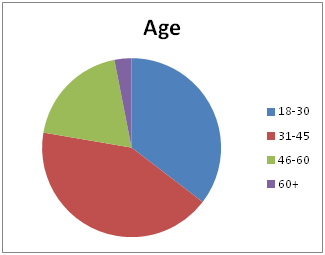
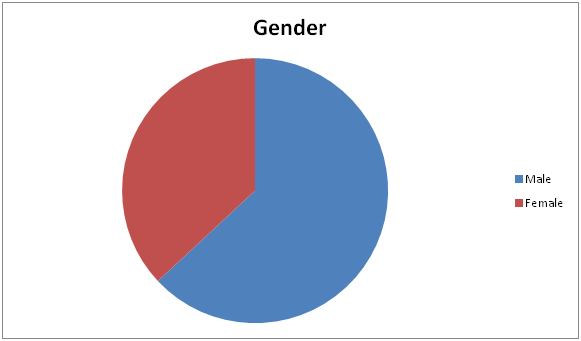
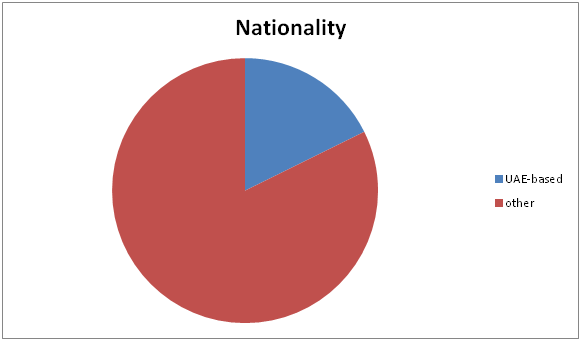
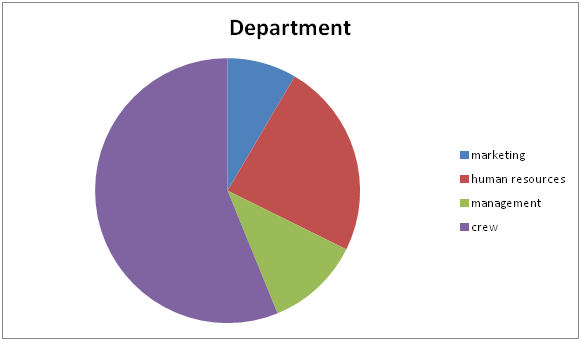
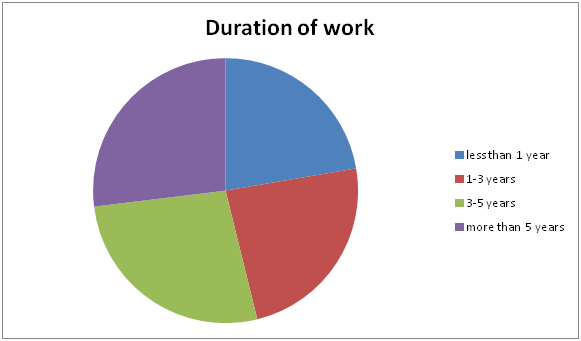
Descriptive Analysis
In this section, the four leadership styles, including autocratic, democratic, transformational, and cross-sectional styles, along with their respective communication strategies and organizational performance, will be analyzed. Each question is based on the Likert scale, which offers five options to choose from (strongly disagree, disagree, neutral, agree, strongly agree). The questions are grouped into four categories, each of which corresponds to a certain leadership style. Each question set comprises statements about the effectiveness and prevalence of the leadership style in a department along with the communication strategies associated with it.
The first group of questions represents the data about the autocratic leadership style, its effectiveness, influence on organizational performance, and respective communication strategies. The results provided in Table 2 are in the form of percentages based on frequency. About 29 percent of respondents remained neutral, especially concerning the prevalence of autocratic leadership in their departments and its impact on organizational performance. In total, 39 percent of participants either disagreed or strongly disagreed with the effectiveness of the autocratic leadership, while about 32 percent supported the statement. These percentages were the result of more than 32 percent of respondents indicating that autocratic leadership style is prevalent in their departments.
Table 2. Autocratic Leadership.
Similar to the first set of questions, the second group depicts results and a summary of aspects related to the democratic style provided in Table 3. About 17 percent of participants reported that democratic leadership is not effective in the organization, 28 percent were neutral, and almost 65 percent agreed with the statements. Based on this data, it is evident that most employees experience democratic leadership styles in their departments, affirm that its communication strategies are the most appealing to them, and indicate a positive impact on the performance of the organization and its employees.
Table 3. Democratic Leadership.
The data provided in Table 4 reflect the results concerning transformational leadership. They are similar to those of the democratic style as about 21 percent of respondents remained neutral, but 22 percent disagreed and 57 percent of participants agreed. It is also evident that a transformational leadership style is prevalent throughout the company, as almost 48 percent of participants indicated that. However, only 9 percent strongly agree that it has a positive impact on organizational performance.
Table 4. Transformational Leadership.
The last set of questions is about the cross-cultural leadership style and its effectiveness. The results provided in Table 5 show that almost 35 percent disagree with the importance of this style, 48 percent agree, and 17 percent are neutral. There is a small gap between those who support and reject the cross-cultural leadership style. However, almost two-thirds of respondents either agree or strongly agree that it has a positive impact on organizational performance.
Table 5. Cross-cultural Leadership.
A complex analysis of data makes it possible to identify which leadership style is prevalent, which is the most preferred, and which is the most effective in terms of communication strategies and impact on organizational performance. The results shown in Figure 6 indicate that the democratic leadership style is the most effective and the most preferred among employees. The indicators for the transformational and cross-cultural styles are similar to those of the democratic style, but with a greater share of those who strongly disagree. Finally, the autocratic leadership style is perceived as the least effective in the organization.
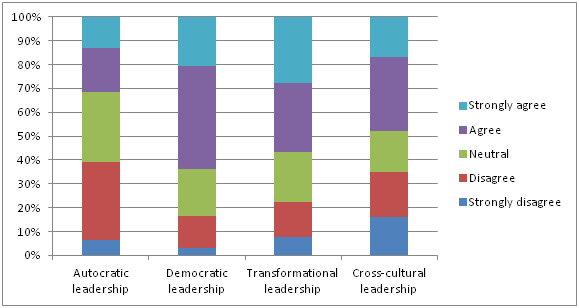
Observations, Conclusions and Recommendations
Observations
The main objectives of this study were to explore the impact of four different leadership styles on the organizational performance of Emirates Airlines. Also, the most effective leadership style and its respective communication strategies were analyzed. Explanatory research design and descriptive analysis methods helped to develop hypotheses, collect information from respondents, and assess it accordingly.
The first hypothesis was that any leadership style and communication strategy has a significant impact on organizational performance. This hypothesis was confirmed, as only about 20 percent of respondents remained neutral, which means that they thought there was no correlation between these variables. The second hypothesis also found support because a majority of employees disagree or strongly disagree with the claim of its effectiveness and positive impact on organizational performance.
Similarly, the third and the fourth hypotheses also found support in the research data because about 65 percent and 57 percent respectively agree or strongly agreed with the statements. Nevertheless, the last hypothesis, stating that cross-cultural leadership has no significant impact on organizational performance, was rejected because almost half of the respondents (48 percent) considered it effective (59 percent agreed or strongly agreed with the statement that cross-cultural leadership has a positive impact on organizational performance).
Conclusions and limitations
This study investigated the influence of four leadership styles on the organizational performance of Emirates Airline from the perspective of communication. A democratic leadership style is perceived as the most effective and influential with appropriate communication strategies that ensure the involvement of employees and boost their effectiveness. However, some inconsistencies were noticed in each set of questions.
For instance, a group of statements about cross-cultural leadership indicated that more than 63 percent of employees saw evidence of it in their departments, but only 22 percent confirmed the effectiveness of the corresponding communication strategies, while 59 percent affirmed its positive impact on organizational performance.
Furthermore, this study has several limitations, which point to aspects that should be investigated further. Each employee may have his or her perception or no understanding of a certain leadership style so that many respondents remained neutral about the statements. Future research should include a short explanation of each leadership style to ensure consistency. Also, data was gathered from four different departments, but more employees from other divisions should be involved. In general, some respondents perceived organizational performance based on that of their particular department, but not that of the company overall.
Recommendations
The results of this study could be useful for the management of Emirates Airlines and other companies in the aviation industry who work in a globalized environment. The data analysis has revealed that the autocratic leadership style is not preferred in organizations, but it could be useful in production-oriented companies (Alkahtani, 2016). Democratic leadership, its communication strategies, and its impact on organizational performance is highly valued by employees. Therefore, leaders need to consider this style in managing their departments and companies.
More than two-thirds of respondents agree or strongly agree that transformational leadership is prevalent in their departments, but its direct impact on organizational performance is not as strong. This evidence may be explained by the fact that senior management started to implement transformational practices only recently when major geopolitical and legislative changes occurred (Powley & Kerr, 2017).
Cross-cultural leadership is also characterized by positive feedback from employees, but its communication strategies should be better developed and implemented. The leaders of Emirates need to consider their approaches to addressing employees of different nationalities equally, as 82 percent of workers are not UAE-born. Overall, experts suggest that there is no single leadership style that can comprehensively address all variables and organizational factors (Khan, Nawaz, & Khan, 2015). Therefore, leaders need to properly diagnose the current organizational environment and contingent factors to lead a company to success.
References
Abbas, W. (2018). Sheikh Ahmed optimistic about Emirates results. Khaleej Times.
Abbas, W. (2019). On time: Emirates second-most punctual airline in Mideast. Khaleej Times.
Al Hammadi, A. (2018). Leadership, strategic planning, organizational performance and innovation: A case of Dubai /UAE public sector. International Journal of Management and Information Technology, 13(1), 3179-3187.
Alkahtani, A. H. (2016). The influence of leadership styles on organizational commitment: The moderating effect of emotional intelligence. Business and Management Studies, 2(1), 23-34.
Alshubaily, A. (2017). Exploring the key success factors for young airlines – A focus on Emirates Airlines and its regional competitors’ strategy for success. Saudi Journal of Business and Management Studies, 2(1), 30-37.
Bhargavi, S. & Yassen, A. (2016). Leadership styles and organizational performance. Strategic Management Quarterly, 4(1), 87-117.
Campbell, M. (2017). Is Emirates Airline running out of sky? Bloomberg.
De Brito Neto, J. F. (2014). Leadership approaches in multi-cultural aviation environments. Journal of Aeronautical Sciences, 5(1), 38-43.
De Waal, A. & Frijns, M. (2016). The influence of the UAE context on management practice in UAE business. International Journal of Islamic and Middle Eastern Finance and Management, 9(2), 236-253.
Khan, Z. A., Nawaz, A., & Khan, I. (2015). Leadership theories and styles: A literature review. Journal of Resources Development and Management, 16(1), 1-7.
Leadership team (n.d.). Web.
Mayfield, J. & Mayfield, M. (2017). Leadership communication: Reflecting, engaging, and innovating. International Journal of Business Communication, 54(1), 3-11.
Powley, T. & Kerr, S. (2017). Emirates president pledges to ‘tough it out’ as airline struggles. Financial Times. Web.
Trapp, R. (2015). Taking leadership to the next level. Forbes.
Yousif, Y. A., Hossan, C., & McNeil, M. (2015). Evaluation of leadership styles in the construction sector of UAE. International Journal of Business and Management, 10(12), 71-79.
Appendix
Questionnaire
Dear Employee,
The group of researchers designed this questionnaire to collect data on the topic “The Impact of Leadership Style on Organizational Performance in Emirates Airline”.
Your response on the subject is highly appreciated. The total time for filling in the questionnaire will not exceed 5 minutes. The data will be collected for an academic purpose only and will be kept confidential. Thank you for your cooperation.
Please, mark the appropriate checkbox or write several words in a corresponding field.
- What is your age?
- 18-30;
- 30-45;
- 45-60;
- 60+.
- What is your gender?
- male;
- female.
- What is your nationality?
- UAE-born;
- other.
- Which department of Emirates Airline are you currently working in?
- marketing;
- human resources;
- management;
- crew staff.
- How many years do you work in the company?
- less than one year;
- 1-3 years;
- 3-5 years;
- more than 5 years.
- Autocratic leadership style is prevalent in my department.
- strongly disagree;
- disagree;
- neutral;
- agree;
- strongly agree.
- Democratic leadership style is prevalent in my department.
- strongly disagree;
- disagree;
- neutral;
- agree;
- strongly agree.
- Transformational leadership style is prevalent in my department.
- strongly disagree;
- disagree;
- neutral;
- agree;
- strongly agree.
- Cross-cultural leadership style is prevalent in my department.
- strongly disagree;
- disagree;
- neutral;
- agree;
- strongly agree.
- Autocratic leadership has the most effective communication strategies.
- strongly disagree;
- disagree;
- neutral;
- agree;
- strongly agree.
- Democratic leadership has the most effective communication strategies.
- strongly disagree;
- disagree;
- neutral;
- agree;
- strongly agree.
- Transformational leadership has the most effective communication strategies.
- strongly disagree;
- disagree;
- neutral;
- agree;
- strongly agree.
- Cross-cultural leadership has the most effective communication strategies.
- strongly disagree;
- disagree;
- neutral;
- agree;
- strongly agree.
- I believe that autocratic leadership has a positive impact on organizational performance.
- strongly disagree;
- disagree;
- neutral;
- agree;
- strongly agree.
- I believe that democratic leadership has a positive impact on organizational performance.
- strongly disagree;
- disagree;
- neutral;
- agree;
- strongly agree.
- I believe that transformational leadership has a positive impact on organizational performance.
- strongly disagree;
- disagree;
- neutral;
- agree;
- strongly agree.
- I believe that cross-cultural leadership has a positive impact on organizational performance.
- strongly disagree;
- disagree;
- neutral;
- agree;
- strongly agree.